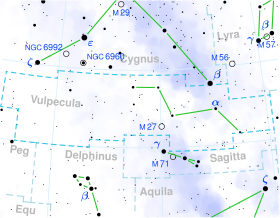
| |
| Observation data Epoch J2000 Equinox J2000 | |
|---|---|
| Constellation | Vulpecula |
| Right ascension | 20 52 07.68352 |
| Declination | 27° 05′ 48.9951″ |
| Apparent magnitude (V) | 4.56 |
| Characteristics | |
| Evolutionary stage | horizontal branch |
| Spectral type | G7IIIa Fe-1 Ba |
| U−B color index | +0.46 |
| B−V color index | +0.82 |
| Variable type | suspected |
| Astrometry | |
| Radial velocity (Rv) | +2.25 km/s |
| Proper motion (μ) | RA: −70.902 mas/yr Dec.: −56.360 mas/yr |
| Parallax (π) | 14.2796 ± 0.1864 mas |
| Distance | 228 ± 3 ly (70.0 ± 0.9 pc) |
| Absolute magnitude (MV) | 0.77 |
| Orbit | |
| Period (P) | 1,860.6±1.3 d |
| Semi-major axis (a) | ≥ 103.0 Gm |
| Eccentricity (e) | 0.375±0.009 |
| Periastron epoch (T) | 52,316±6 MJD |
| Argument of periastron (ω) (secondary) | 15.1±1.4° |
| Semi-amplitude (K1) (primary) | 4.34±0.04 km/s |
| Details | |
| 31 Vul A | |
| Mass | 2.40±0.05 M☉ |
| Radius | 8.01±0.30 R☉ |
| Luminosity | 52.53 L☉ |
| Surface gravity (log g) | 2.97±0.05 cgs |
| Temperature | 5,261±15 K |
| Metallicity | −0.05±0.02 dex |
| Rotational velocity (v sin i) | 5.9±0.3 km/s |
| Age | 700±40 Myr |
| Other designations | |
| 31 Vul, BD+26°4017, GC 29112, HD 198809, HIP 103004, HR 7995, SAO 89228, 2MASS J20520768+2705491 | |
| Database references | |
| SIMBAD | data |
31 Vulpeculae is a binary star system in the northern constellation of Vulpecula. It is visible to the naked eye as a faint, yellow-hued point of light with an apparent visual magnitude of 4.56. The system is located approximately 228 light years away from the Sun based on parallax, and it is drifting further away with a radial velocity of +2.25 km/s.
The variable radial velocity of this system was first suspected by German Astronomer Friedrich Küstner in 1914. The system appears as a single-lined spectroscopic binary with an orbital period of 5.1 years and an eccentricity of 0.38. The a sin i value for the primary is 103.0 ± 1.1 Gm (0.69 ± 0.01 AU), where a is the semimajor axis and i is the (unknown) orbital inclination. This value provides a lower bound on the actual semimajor axis for the orbit.
The primary component is an aging giant star with a stellar classification of G7IIIa Fe-1 Ba, indicating a mild barium star with an underabundance of iron. Having exhausted the supply of hydrogen at its core, it has expanded to eight times the Sun's radius. It is a red clump giant, which indicates it is on the horizontal branch and is generating energy through helium fusion at its core. This is a suspected variable star with a magnitude that varies from 3.77 to 4.08 in the I passband. It is about 700 million years old with 2.4 times the mass of the Sun. The star is radiating 53 times the luminosity of the Sun from its enlarged photosphere at an effective temperature of 5,261 K. The companion may be a degenerate white dwarf with about 0.4 M☉.
References
- ^ Brown, A. G. A.; et al. (Gaia collaboration) (August 2018). "Gaia Data Release 2: Summary of the contents and survey properties". Astronomy & Astrophysics. 616. A1. arXiv:1804.09365. Bibcode:2018A&A...616A...1G. doi:10.1051/0004-6361/201833051. Gaia DR2 record for this source at VizieR.
- ^ Anderson, E.; Francis, Ch. (2012). "XHIP: An extended hipparcos compilation". Astronomy Letters. 38 (5): 331. arXiv:1108.4971. Bibcode:2012AstL...38..331A. doi:10.1134/S1063773712050015. S2CID 119257644. Vizier catalog entry
- ^ Mallama, A. (2014). "Sloan Magnitudes for the Brightest Stars". The Journal of the American Association of Variable Star Observers. 42 (2): 443. Bibcode:2014JAVSO..42..443M.Vizier catalog entry
- ^ Samus, N. N.; Durlevich, O. V.; et al. (2009). "General Catalogue of Variable Stars". VizieR On-line Data Catalog: B/GCVS. Originally Published in: 2009yCat....102025S. 1. Bibcode:2009yCat....102025S.
- ^ Soubiran, C.; Bienaymé, O.; Mishenina, T. V.; Kovtyukh, V. V. (2008). "Vertical distribution of Galactic disk stars". Astronomy and Astrophysics. 480 (1): 91–101. arXiv:0712.1370. Bibcode:2008A&A...480...91S. doi:10.1051/0004-6361:20078788. S2CID 16602121.
- Da Silva, Ronaldo; et al. (2015). "Homogeneous abundance analysis of FGK dwarf, subgiant, and giant stars with and without giant planets". Astronomy & Astrophysics. 580: A24. arXiv:1505.01726. Bibcode:2015A&A...580A..24D. doi:10.1051/0004-6361/201525770. S2CID 119216425. Vizier catalog entry
- ^ Griffin, R. F. (August 2009). "Spectroscopic binary orbits from photoelectric radial velocities. Paper 207: 58 Piscium, 31 Vulpeculae, and 70 Pegasi". The Observatory. 129: 198–218. Bibcode:2009Obs...129..198G.
- ^ Maldonado, J.; Villaver, E. (April 2016). "Evolved stars and the origin of abundance trends in planet hosts". Astronomy & Astrophysics. 588: 11. arXiv:1602.00835. Bibcode:2016A&A...588A..98M. doi:10.1051/0004-6361/201527883. S2CID 119212009. A98.
- "31 Vul". SIMBAD. Centre de données astronomiques de Strasbourg. Retrieved 2019-07-13.
- Alves, David R. (August 2000), "K-Band Calibration of the Red Clump Luminosity", The Astrophysical Journal, 539 (2): 732–741, arXiv:astro-ph/0003329, Bibcode:2000ApJ...539..732A, doi:10.1086/309278, S2CID 16673121
External links
- 31 Vulpeculae on WikiSky: DSS2, SDSS, GALEX, IRAS, Hydrogen α, X-Ray, Astrophoto, Sky Map, Articles and images
| Constellation of Vulpecula | |||||||||||||
|---|---|---|---|---|---|---|---|---|---|---|---|---|---|
| Stars |
| ||||||||||||
| |||||||||||||
| |||||||||||||
| |||||||||||||
| Galaxies |
| ||||||||||||
| |||||||||||||